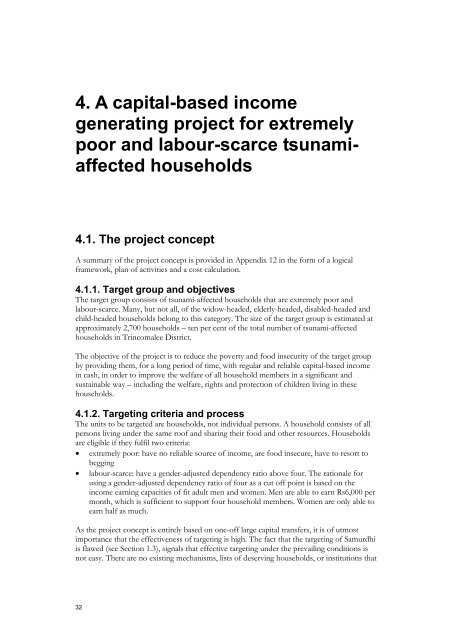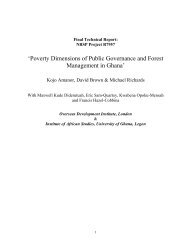Feasibility study on a capital-based income generation scheme for ...
Feasibility study on a capital-based income generation scheme for ...
Feasibility study on a capital-based income generation scheme for ...
Create successful ePaper yourself
Turn your PDF publications into a flip-book with our unique Google optimized e-Paper software.
CASH FOR RECOVERY<br />
4. A <strong>capital</strong>-<strong>based</strong> <strong>income</strong><br />
generating project <strong>for</strong> extremely<br />
poor and labour-scarce tsunamiaffected<br />
households<br />
4.1. The project c<strong>on</strong>cept<br />
A summary of the project c<strong>on</strong>cept is provided in Appendix 12 in the <strong>for</strong>m of a logical<br />
framework, plan of activities and a cost calculati<strong>on</strong>.<br />
4.1.1. Target group and objectives<br />
The target group c<strong>on</strong>sists of tsunami-affected households that are extremely poor and<br />
labour-scarce. Many, but not all, of the widow-headed, elderly-headed, disabled-headed and<br />
child-headed households bel<strong>on</strong>g to this category. The size of the target group is estimated at<br />
approximately 2,700 households – ten per cent of the total number of tsunami-affected<br />
households in Trincomalee District.<br />
The objective of the project is to reduce the poverty and food insecurity of the target group<br />
by providing them, <strong>for</strong> a l<strong>on</strong>g period of time, with regular and reliable <strong>capital</strong>-<strong>based</strong> <strong>income</strong><br />
in cash, in order to improve the welfare of all household members in a significant and<br />
sustainable way – including the welfare, rights and protecti<strong>on</strong> of children living in these<br />
households.<br />
4.1.2. Targeting criteria and process<br />
The units to be targeted are households, not individual pers<strong>on</strong>s. A household c<strong>on</strong>sists of all<br />
pers<strong>on</strong>s living under the same roof and sharing their food and other resources. Households<br />
are eligible if they fulfil two criteria:<br />
• extremely poor: have no reliable source of <strong>income</strong>, are food insecure, have to resort to<br />
begging<br />
• labour-scarce: have a gender-adjusted dependency ratio above four. The rati<strong>on</strong>ale <strong>for</strong><br />
using a gender-adjusted dependency ratio of four as a cut off point is <strong>based</strong> <strong>on</strong> the<br />
<strong>income</strong> earning capacities of fit adult men and women. Men are able to earn Rs6,000 per<br />
m<strong>on</strong>th, which is sufficient to support four household members. Women are <strong>on</strong>ly able to<br />
earn half as much.<br />
As the project c<strong>on</strong>cept is entirely <strong>based</strong> <strong>on</strong> <strong>on</strong>e-off large <strong>capital</strong> transfers, it is of utmost<br />
importance that the effectiveness of targeting is high. The fact that the targeting of Samurdhi<br />
is flawed (see Secti<strong>on</strong> 1.3), signals that effective targeting under the prevailing c<strong>on</strong>diti<strong>on</strong>s is<br />
not easy. There are no existing mechanisms, lists of deserving households, or instituti<strong>on</strong>s that<br />
32
















